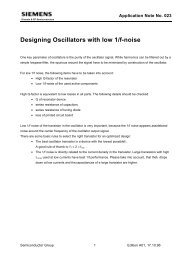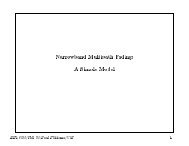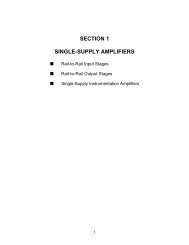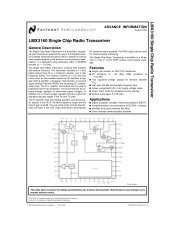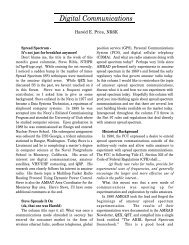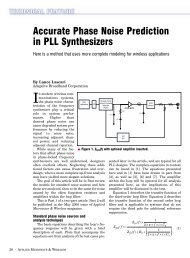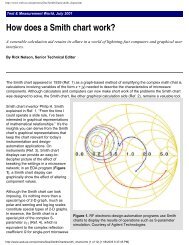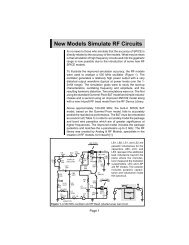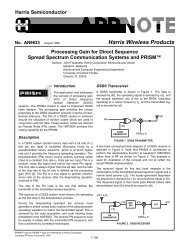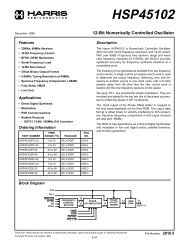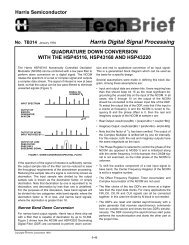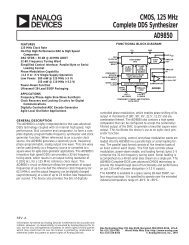Cellular Digital Packet Data (CDPD) - Bnrg.cs.berkeley.edu ...
Cellular Digital Packet Data (CDPD) - Bnrg.cs.berkeley.edu ...
Cellular Digital Packet Data (CDPD) - Bnrg.cs.berkeley.edu ...
You also want an ePaper? Increase the reach of your titles
YUMPU automatically turns print PDFs into web optimized ePapers that Google loves.
CS 294-7: <strong>Cellular</strong> <strong>Digital</strong> <strong>Packet</strong><strong>Data</strong> (<strong>CDPD</strong>)Prof. Randy H. KatzCS DivisionUniversity of California, BerkeleyBerkeley, CA 94720-1776© 19961
<strong>Cellular</strong> <strong>Digital</strong> <strong>Packet</strong> <strong>Data</strong>• IBM, McCaw <strong>Cellular</strong>• <strong>Data</strong> network overlay on analog cellulartelephone system• Uses same 30 KHz channels @ 800 MHz;potentially same coverage as cellular system• Sch<strong>edu</strong>le data packets to unused voicechannels• (Up to) 19.2 kbps• Provides IP packet service2
<strong>Cellular</strong> <strong>Digital</strong> <strong>Packet</strong> <strong>Data</strong>ISIntermediate System:Routes to Corporate and Value-Addednetworks like the InternetMD-ISMobile <strong>Data</strong> Intermediate System:Mobility managementM-ESMD-BSMobile <strong>Data</strong> Base Station:Collocated with cellular MTSOManages cells/air interfacesMobile End Station:terminal, laptop3
<strong>CDPD</strong> Network ArchitectureAirlink I/FExternal I/FM-ES MDBS MD-IS ISF-ESF-ESInterserviceProviderInterfaceISISDomain ofone serviceprovider4
<strong>CDPD</strong> Network ArchitectureColor Code XMDBSRegions under the controlof an MD-IS identified bycolor codes in all messagesM-ES MDBS MD-IS ISMDBSMD-ISISColor Code YMDBS5
<strong>CDPD</strong> Entities• M-ES– <strong>CDPD</strong> network trackes location of ES’ and routes themnetwork datagrams– ES’ address does NOT imply location; currentsubnetwork “point of attachment” determines this– ES’ are associated with the <strong>CDPD</strong> network’s routingdomain, not the user’s corporate home network– Mobility support functions:» Mobility management: tracking MDES and routing» Radio resource management: connectivity tosubnetwork “point of attachment”6
<strong>CDPD</strong> Entities• Fixed End Systems (F-ES)– Fixed location, traditional routing can be used– Internal F-ES: provided by service provider, consideredto be inside the security firewall» For authentication, authorization, network mgmt,accounting» For domain name services, location services, etc.– External F-ES: external to <strong>CDPD</strong>, must operate over theexternal network interface7
<strong>CDPD</strong> Entities• Intermediate Systems (IS, MD-IS)– IS provides routing (can be off-the-shelf– MD-IS provides MOBILE routing: MNLP (Mobile NetworkLocation Protocol)» Mobile Home Function: like home agent processingin Mobile IP or HLR function in cellular networks;uses encapsulation to forward packets to MD-IS inthe visited region» Mobile Serving Function: like foreign agentprocessing in Mobile IP or VLR function in cellularnetworks;Registration/authentication/authorization/accounting8
<strong>CDPD</strong> Entities• Mobile <strong>Data</strong> Base Station (MD-BS)– Controls radio interface, responsible for radio channelallocation, radio media access» RF Channel Pair:Forward link from BS to multiple ESsReverse link from multiple ESs to BS– Colocated with cellular voice equipment– <strong>CDPD</strong> channels must be able to hop to new frequenciesas demanded by the voice services9
<strong>CDPD</strong> ProtocolsM-ESIP/CLNPSNDCPMDBSMD-ISIP/CLNPRelayIP/CLNPSNDCPMDLPMACPhysicalMACPhysicalMDLP RelayTP4CLNPSNDCFX.25/LAPD/PPPDS0/EthernetMDLPTP4CLNPSNDCFX.25/LAPD/PPPDS0/Ethernet10
<strong>CDPD</strong> ProtocolsNetwork Layer <strong>Data</strong>Network Layer <strong>Data</strong>HeadersHeader CompressionEncryptionCompressedHeadersNetwork LayerSNDCP(Subnet Layer)Encrypted <strong>Packet</strong>SegmentationSegment Segment Segment SegmentHeaderFramingFrame Frame FrameInformation Bit Stream CreationFrameHeaderFrame Frame Frame FrameFlagBlockingMDLP(Link Layer)DSMA/CD(MAC Layer)FECBlockFECBlockFECBlockFEC Block RS (63,47)Physical11
<strong>CDPD</strong> Protocols• Physical Layer– GMSK modulation, raw data rate = 19.2 Kbps;Actually data rate will be (much) less– Restricted to using pair of analog or digital TDMA cellularvoice frequency pairs for each physical <strong>CDPD</strong> channel– Physical layer services:» Tune to specified pair of RF channels» Transmit/receive bits» Set power levels» Measure signal strengths» Suspend/resume monitoring of RF channels in M-ESto conserve battery power12
<strong>CDPD</strong> Protocols• MAC Layer– Arbitrate access to shared medium between M-ES andMD-BS– Frame recognition, frame delimiting, error detection/correctionMD-ES MD-ES MD-ESMD-BSForward LinkReverse LinkForward link: sch<strong>edu</strong>led by BS, signals channel idle/busyReverse link: contention access with back-off13
<strong>CDPD</strong> Protocols• MAC Layer (continued)– Forward channel:» <strong>Data</strong> packets “broadcast” from BS to ESHDLC, zero insertion, frames segmented into 274 bit(+8 bit color code) blocks, extended with ECC to 378 bits» Forward channel sync word, reverse channel busy/idle flag,decode failure flags, 378 RS (63, 47) block– Reverse channel:» DSMA/CD access strategy» 378 bit blocks/up to 64 of these per burst» M-ES will back off and retry whenever it senses decode failureflag on the forward channel14
<strong>CDPD</strong> Protocols• Mobile <strong>Data</strong> Link Protocol (MDLP)– Point (MDIS) to multipoint (M-ES), connection-oriented,fully sequenced, acknowledged transfers– Functions provided include:» One or more logical data link connections on achannel stream» Sequence control» Transmission/format/operational error detection andrecovery—retransmits missing blocks» Flow control» Sleep function for power conservation» Dynamic address assignment (Temporary EquipmentID--TEI)15
<strong>CDPD</strong> Protocols• Subnetwork Dependent Convergence Protocol(SNDCP)– Connectionless mode subnetwork service– Provides the following functions:» Mapping of data primitives» Segmentation/reassembly of NPDUs» Compression/elimination of r<strong>edu</strong>ndant protocol controlinformation» Encryption/decryption» Network layer to data link layer multiplexing to supportmultiple network layer protocols on top of the data link16
Mobile Network RegistrationProtocol (MNRP)• Connectionless, exchanges configurationinformation between M-ES and MD-IS– Network Entity Identifier (NEI)– Subnet Point of Attachment (SNPA)• Provides following functions:– Registration/deregistration of NEIs with MD-IS– Authentication of M-ES and its NEI– Admission of M-ES to services offered by MD-IS• Mobile Home Function– Location Directory , redirection and forwarding• Mobile Serving Function– Registration Directory, readdress “decapsulation”service17
Radio Resource Management• <strong>CDPD</strong> transmission is frequency agile, mobileacross adjacent cells (“cell transfers”)• In-band control, unlike AMPS cellular• Function provided include:– Allocating RF channel pair to <strong>CDPD</strong> service– Hopping to new RF channel pair, because of analog voicedemand or for <strong>CDPD</strong> channel load balancing– Controlling M-ES’s transmit power– Configuration information exchange» Cell ID, channel stream, service provider, home area» RF channels for <strong>CDPD</strong> use, channels to hop to» This information is periodically broadcast from BS– Admission control to channel stream18
M-ES Channel Hopping• Initiation Phase– Conditions for channel hopping are met» Detection of new color code» Loss of sync» Weak forward channel signal» Excessive block errors» OR “directed hop” message from the BS• Execution Phase– Uses information from previous configuration messages– E.g., “in-use” RF channels, “allocated” RF channels, “inuse”and “allocated” RF channels of adjacent cells• Termination Phase19
Air Link Security• Encrypted airlink yields data link confidentiality• M-ES NEI authentication by <strong>CDPD</strong> network• Authentication process based on registrationhistory– MD-IS authenticates M-ES back to its home MD-IS– NEI/ASN (Auhentication Sequence Number)/ARN(Authentication Random Number) are the authenticationcredentials– ASN incremented after each successful registration– New ARN assigned by MHF after every successful validationof credentials; obtained over encrypted link by M-ES whichstores it locally20
Network Layer Mobility:<strong>CDPD</strong> vs. Mobile IP• Home Agent– <strong>CDPD</strong>: Location Directory– Mobile IP: Configuration and Registration Table– Mobility Binding: binding between a mobile host and itsattachment agent, registration lifetime, id number, etc.• Attachment Agent– <strong>CDPD</strong>: Registration Directory– Mobile IP: Configuration and Registration Table<strong>Packet</strong>s for MHrouted to HAHAHostHA encapsulatespacket and tunnelsit to FAAttachmentAgentMHFA decapsulatesinner packet anddelivers it to MH21
Network Layer Mobility:<strong>CDPD</strong> vs. Mobile IPMHAttachAgentHA<strong>CDPD</strong>: End System HelloM-IP: Registration Request<strong>CDPD</strong>: Redirect RequestIP: Registration Request<strong>CDPD</strong>: Redirect ReplyIP: Registration Reply<strong>CDPD</strong>: Intermediate System ConfirmIP: Registration Reply<strong>CDPD</strong>: Redirect FlushPriorAttachAgent22
Network Layer Mobility:<strong>CDPD</strong> vs Mobile IPIPMNRP<strong>CDPD</strong>RegProtocolMNRPIPLocation ProtocolCNLP MNLPCNLP MNLPIPIPMobileIPUDPIPMobile IPRegistration FlowsUDPIPMobile IPMobileIPUDPIPIPSNDCPSNDCPMDLPMDLPMHAttachmentAgentHAESMHAttachmentAgentHACH23
Network Layer Mobility:<strong>CDPD</strong> vs. Mobile IP• Information sent by Mobile Nodes to Attachment AgentParameter DescriptionPermanent IP address of mobile nodeSequence control for reg requestsAuthentication: Mobile Node—HAIdentity of Mobile Node’s HARequested Lifetime of RegistrationTunnel EndpointRequest for HA to maintain multiple regsimultaneously*Authentication: Mobile Node—Attach AgentTraffic Encapsulation btwn HA and AANon-default Authent method & crypto keyMobile IPHome AddressIdentificationMH Authen ExtensionHALifetimeCare-Of AddressCodeMobile-Foreign Authen ExtMin Encapsulation ExtKey ID<strong>CDPD</strong>Src Network AddressRegistration CountAuthentication ParameterOptionalFootnotes:* Mobile IP allows MH to be registered with multiple FAs; <strong>CDPD</strong> does not<strong>CDPD</strong>: End System Hello messageMobile IP: Registration Request message24
Network Layer Mobility:<strong>CDPD</strong> vs. Mobile IP• Information sent by Attachment Agent to Home AgentParameter DescriptionPermanent IP address of mobile nodeSequence control for reg requestsAuthentication: Mobile Node—HAIdentity of Mobile Node’s HARequested Lifetime of RegistrationTunnel EndpointRequest for HA to maintain multiple regsimultaneously*Authentication: Mobile Node—Attach AgentTraffic Encapsulation btwn HA and AANon-default Authent method & crypto keyCarrier affiliation of Attachment AgentMobile IPHome AddressIdentificationMH Authen ExtensionHALifetimeCare-Of AddressCodeMobile-Foreign Authen ExtMin Encapsulation ExtKey ID<strong>CDPD</strong>Src Network AddressRegistration CountAuthentication ParameterForeign Network AddressLocation InfoAA forwards registration request to Home Agent<strong>CDPD</strong>: Redirect Request messageMobile IP: Registration Request agent25
Network Layer Mobility:<strong>CDPD</strong> vs. Mobile IP• Information sent by Home Agent to Attachment AgentParameter DescriptionPermanent IP address of mobile nodeSequence control for reg requestsAuthentication: Mobile Node—HAAssigned Lifetime of RegistrationDisposition of RequestAuthentication: Mobile Node—Attach AgentAuthentication: HA—AAFilter to limit range of addrs handled by HAUsage InformationMobile IPIdentificationMH Authen ExtensionLifetimeCodeMobile-Foreign Authen ExtForeign-Home Authen Ext<strong>CDPD</strong>Dst Network AddressRegistration Seq CountAuthent Update ParameterConfiguration TimerResult CodeAddress MaskHome InfoHA receives registration request from Mobile NodeHA decides whether to confirm or deny requestResult is forwarded to AA, who forwards it to the Mobile Node<strong>CDPD</strong>: Redirect Confirm messageMobile IP: Registration Reply message26
Network Layer Mobility:<strong>CDPD</strong> vs. Mobile IP• Information sent by Attachment Agent to Mobile HostParameter DescriptionPermanent IP address of mobile nodeSequence control for reg requestsAuthentication: Mobile Node—HAAssigned Lifetime of RegistrationDisposition of RequestAuthentication: Mobile Node—Attach AgentMobile IPIdentificationMH Authen ExtensionLifetimeCodeMobile-Foreign Authen Ext<strong>CDPD</strong>Dst Network AddressAuthent Update ParameterConfiguration TimerResult CodeAA passes confirmation or rejection to MH<strong>CDPD</strong>: Hello Confirm messageMobile IP: Registration Reply message27
• <strong>CDPD</strong>:Network Layer Mobility:<strong>CDPD</strong> vs. Mobile IP+ Complete lower layer solution for mobility– Limited scalability to support more than seven carriers– Lack of hooks to accommodate comprehensive security andauthentication protocols (airlink secure, but backbone is not!)• Mobile IP:+ Can accommodate robust set of security protocols (end-to-endsecurity is possible)+ Can scale to handle mobility across many routing domains– Failure of the AA to participate actively in registration process– No well defined wireless link– No network management functions defined28



